Lesson 14
Alternate Interior Angles
14.1: Angle Pairs (5 minutes)
Warm-up
This task is designed to prompt students to recall their prior work with supplementary angles. While they have seen this material in grade 7, this is the first time it has come up explicitly in grade 8. As students work on the task, listen to their conversations specifically for the use of vocabulary such as supplementary and vertical angles. If no students use this language, make those terms explicit in the discussion.
Some students may wish to use protractors, either to double check work or to investigate the different angle measures. This is an appropriate use of technology (MP5), but ask these students what other methods they could use instead.
Launch
Provide access to geometry toolkits. Before students start working, make sure they are familiar with the convention for naming an angle using three points, where the middle letter denotes the angle’s vertex.
Student Facing
-
Find the measure of angle \(JGH\). Explain or show your reasoning.

-
Find and label a second \(30^\circ\) degree angle in the diagram. Find and label an angle congruent to angle \(JGH\).
Student Response
For access, consult one of our IM Certified Partners.
Activity Synthesis
Display the image for all to see. Invite students to share their responses, adding onto the image as needed to help make clear student thinking. If not mentioned by students, make sure to highlight the term supplementary angles to describe, for example, angles \(FGJ\) and \(JGH\), and vertical angles to describe, for example, angles \(JGF\) and \(HGI\).
14.2: Cutting Parallel Lines with a Transversal (15 minutes)
Activity
In this task, students explore the relationship between angles formed when two parallel lines are cut by a transversal line. Students investigate whether knowing the measure of one angle is sufficient to figure out all the angle measures in this situation. They also consider whether the relationships they found hold true for any two lines cut by a transversal.
The last two questions in this activity are optional, to be completed if time allows. Make sure to leave enough time for the next activity, “Alternate Interior Angles are Congruent.”
As students work with their partners, they begin to fill in supplementary angles and vertical angles. To find the measures of corresponding and alternate interior, students may use tracing paper and some of the strategies found earlier in the unit. For example, they may use tracing paper to translate vertex \(B\) to vertex \(E\). They might try to translate \(B\) to \(E\) in the third picture and observe that the angles at those two vertices are not congruent. Similarly, to find measures of vertical angles students may use a \(180^\circ\) rotation like they did earlier in this unit when showing that vertical angles are congruent. Monitor for students who use these different strategies and select them to share during the discussion.
For students who finish early, ask them to think of different methods they could use to determine the angles: For example, all of the congruent angles can be shown to be congruent with transformations.
Launch
A transversal (or transversal line) for a pair of parallel lines is a line that meets each of the parallel lines at exactly one point. Introduce this idea and provide a picture such as this picture where line \(k\) is a transversal for parallel lines \(\ell\) and \(m\):
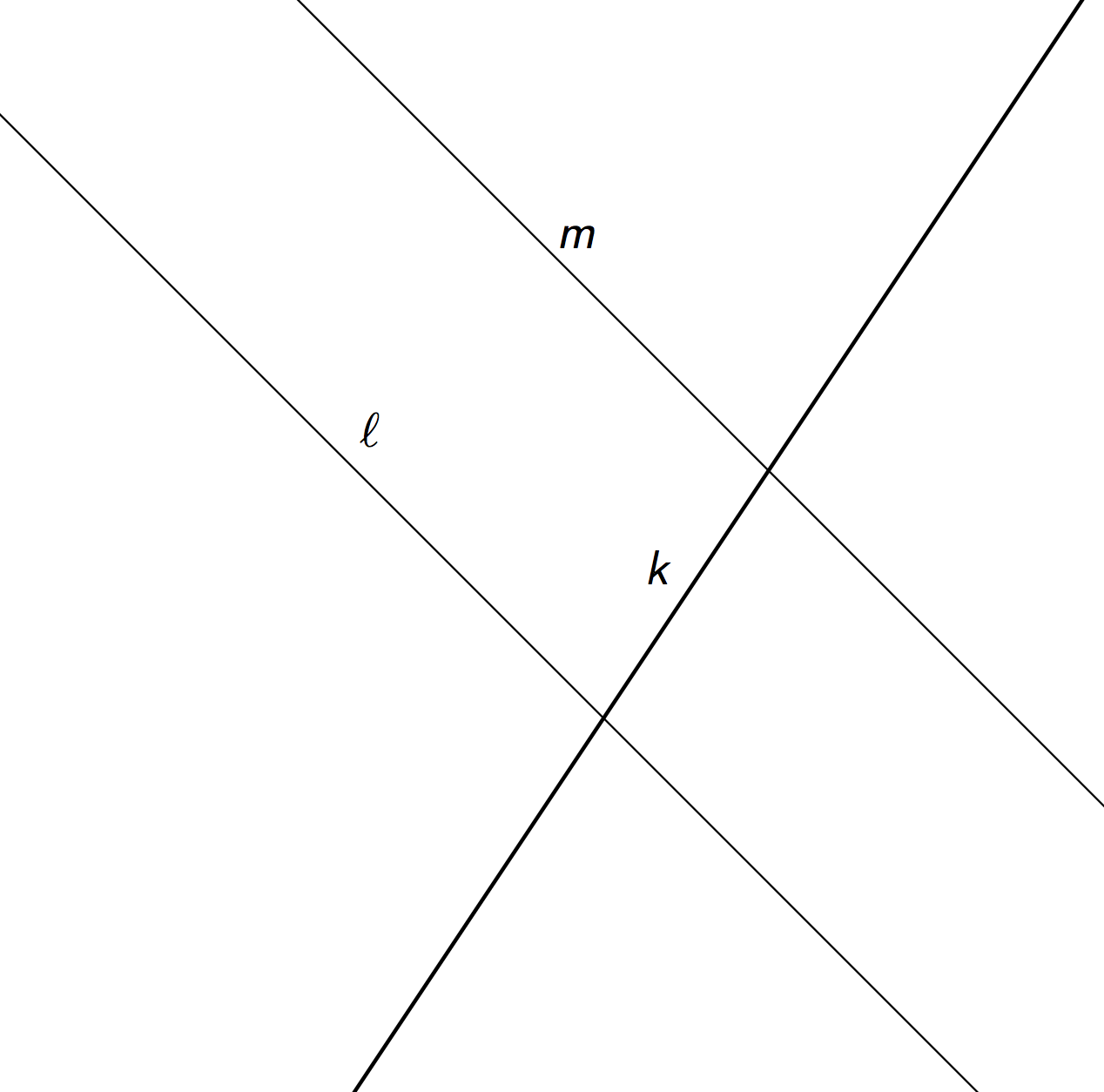
Arrange students in groups of 2. Provide access to geometry toolkits. Give students 1 minute of quiet think time to plan on how to find the angle measures in the picture then time to share their plan with their partner. Give partners time for the rest of the task, followed by a whole-class discussion. Instruct students to stop after the third question if you've decided to skip the last two questions.
Supports accessibility for: Conceptual processing; Language
Design Principle(s): Support sense-making
Student Facing
Lines \(AC\) and \(DF\) are parallel. They are cut by transversal \(HJ\).

-
With your partner, find the seven unknown angle measures in the diagram. Explain your reasoning.
-
What do you notice about the angles with vertex \(B\) and the angles with vertex \(E\)?
-
Using what you noticed, find the measures of the four angles at point \(B\) in the second diagram. Lines \(AC\) and \(DF\) are parallel.
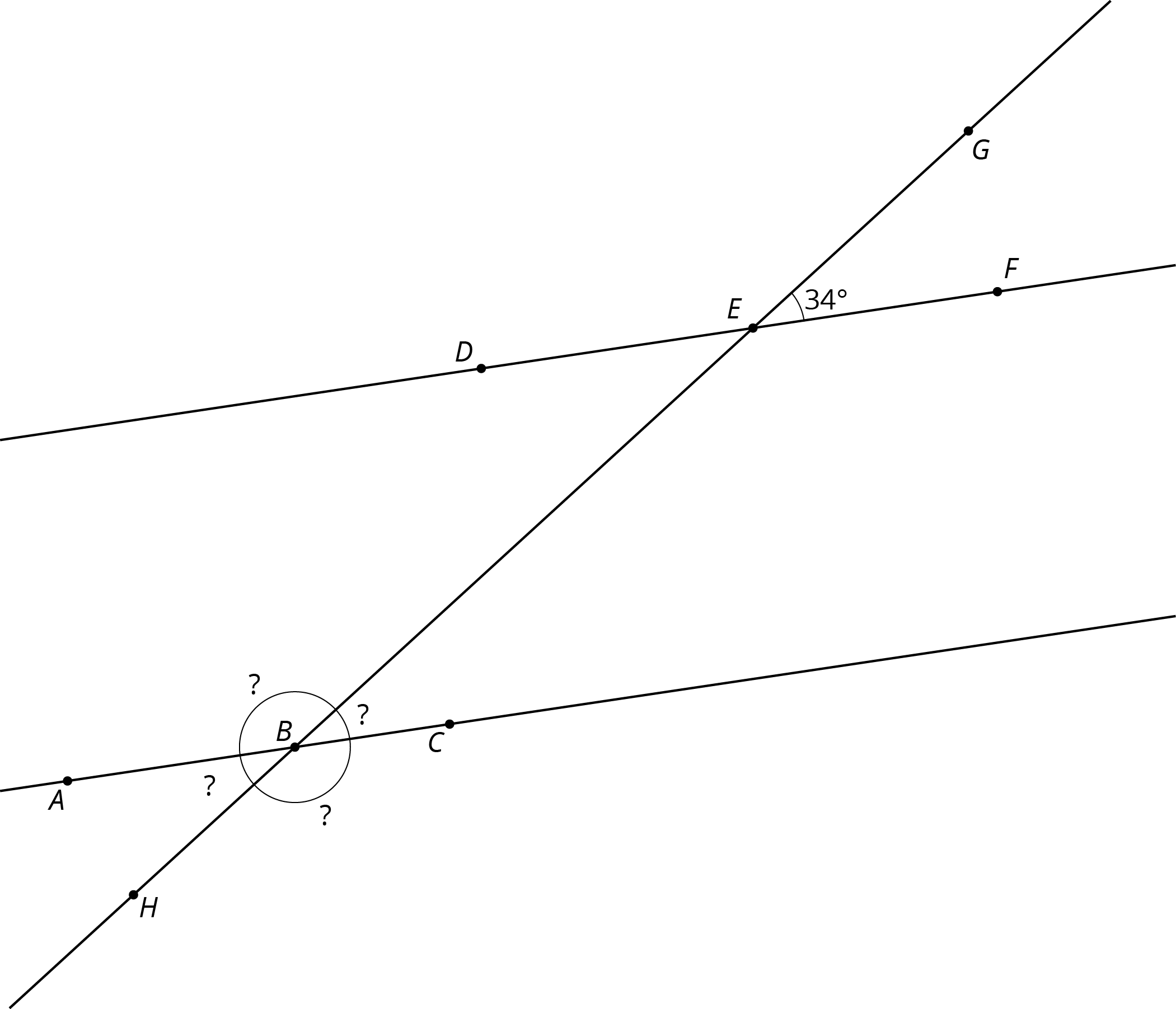
-
The next diagram resembles the first one, but the lines form slightly different angles. Work with your partner to find the six unknown angles with vertices at points \(B\) and \(E\).

-
What do you notice about the angles in this diagram as compared to the earlier diagram? How are the two diagrams different? How are they the same?
Student Response
For access, consult one of our IM Certified Partners.
Student Facing
Are you ready for more?

Parallel lines \(\ell\) and \(m\) are cut by two transversals which intersect \(\ell\) in the same point. Two angles are marked in the figure. Find the measure \(x\) of the third angle.
Student Response
For access, consult one of our IM Certified Partners.
Anticipated Misconceptions
In the first image, students may fill in congruent angle measurements based on the argument that they look the same size. Ask students how they can be certain that the angles don't differ in measure by 1 degree. Encourage them a way to explain how we can know for sure that the angles are exactly the same measure.
Activity Synthesis
The purpose of this discussion is to make sure students noticed relationships between the angles formed when two parallel lines are cut by a transversal and to introduce the term alternate interior angles to students. Display the images from the Task Statement for all to see one at a time and invite groups to share their responses. Encourage students to use precise vocabulary, such as supplementary and vertical angles, when describing how they figured out the different angle measurements. After students point out the matching angles at the two vertices, define the term alternate interior angles and ask a few students to identify some pairs of angles from the activity.
Consider asking some of the following questions:
- "What were some tools you used to find or confirm angle measures?" (Tracing paper, protractor, transformations)
- "What were some angle relationships you used to find missing measures?" (Vertical angles, supplementary angles)
- "What do you notice about the angles at vertex \(B\) compared to the angles at vertex \(E\)?" (They have the same angle measures for angles in the same position relative to the transversal.)
- "Which angle relationships were true for all three pictures? Which were true for only one or two of the pictures?" (Congruent vertical and supplementary angles around a vertex were always true. Congruent angles in corresponding positions at the two vertices were only true in the first two pictures, which had parallel lines.)
14.3: Alternate Interior Angles Are Congruent (15 minutes)
Activity
The goal of this task is to experiment with rigid motions to help visualize why alternate interior angles (made by a transversal connecting two parallel lines) are congruent. This result will be used in a future lesson to establish that the sum of the angles in a triangle is 180 degrees. The second question is optional if time allows. This provides a deeper understanding of the relationship between the angles made by a pair of (not necessarily parallel) lines cut by a transversal.
Expect informal arguments as students are only beginning to develop a formal understanding of parallel lines and rigid motions. They have, however, studied the idea of 180 degree rotations in a previous lesson where they used this technique to show that a pair of vertical angles made by intersecting lines are congruent. Consider recalling this technique especially to students who get stuck and suggesting the use of tracing paper.
Given the diagram, the tracing paper, and what they have learned in this unit, students should be looking for ways to demonstrate that alternate interior angles are congruent using transformations. Make note of the different strategies (including different transformations) students use to show that the angles are congruent and invite them to share their strategies during the discussion. Approaches might include:
- A 180 degree rotation about \(M\)
- First translating \(P\) to \(Q\) and then applying a 180-degree rotation with center \(Q\)
Launch
Provide access to geometry toolkits. Tell students that in this activity, we will try to figure out why we saw all the matching angles we did in the last activity.
Supports accessibility for: Language; Organization
Student Facing
-
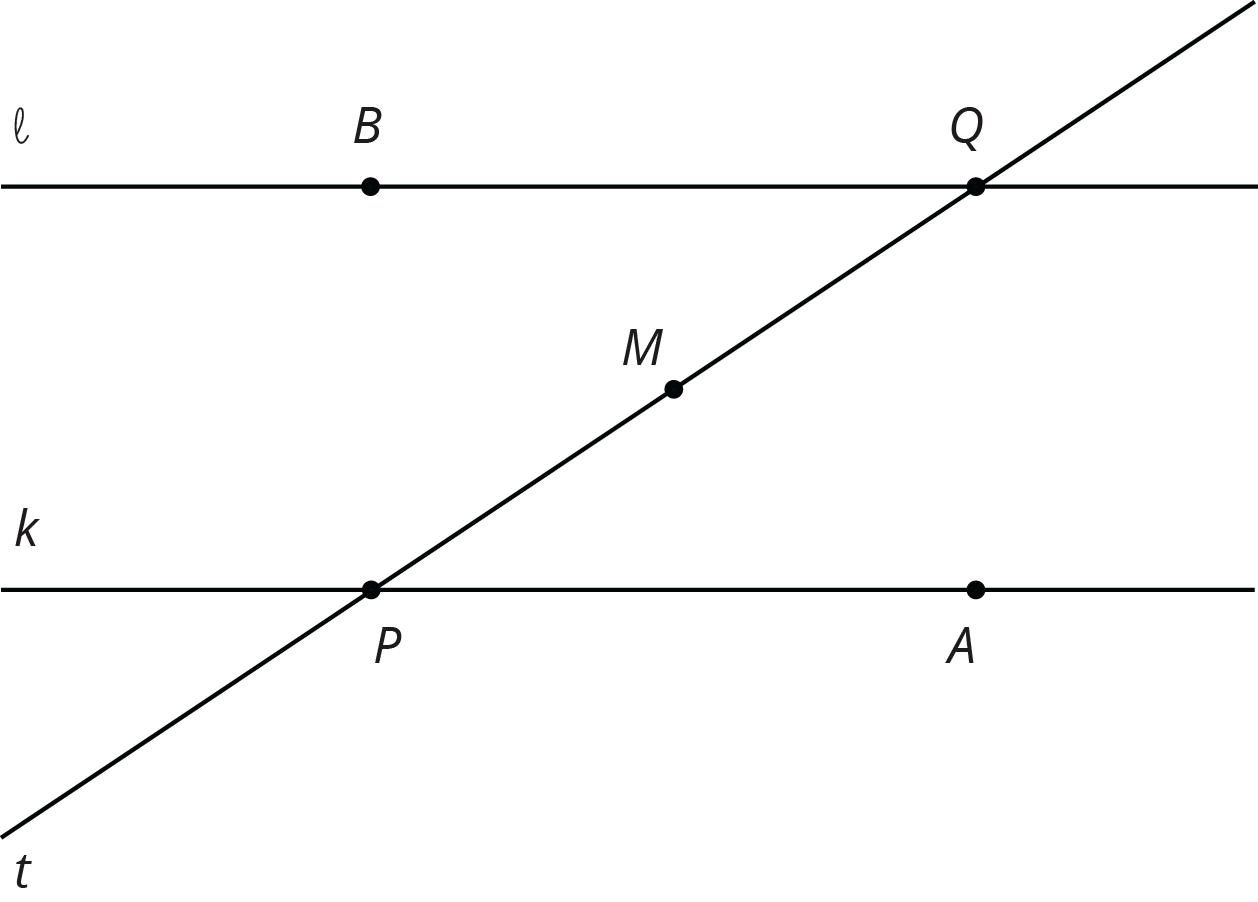
- In this picture, lines \(\ell\) and \(k\) are no longer parallel. \(M\) is still the midpoint of segment \(PQ\).

Does your argument in the earlier problem apply in this situation? Explain.
Student Response
For access, consult one of our IM Certified Partners.
Activity Synthesis
Select students to share their explanations. Pay close attention to which transformations students use in the first question and make sure to highlight different possibilities if they arise. Ask students to describe and demonstrate the transformations they used to show that alternate interior angles are congruent.
Highlight the fact that students are using many of the transformations from earlier sections of this unit. The argument here is especially close to the one used to show that vertical angles made by intersecting lines are congruent. In both cases a 180 degree rotation exchanges pairs of angles. For vertical angles, the center of rotation is the common point of intersecting lines. For alternate interior angles, the center of rotation is the midpoint of the transverse between the two parallel lines. But the structure of these arguments is identical.
Design Principle(s): Support sense-making, Optimize output (for explanation)
Lesson Synthesis
Lesson Synthesis
Display the image of two parallel lines cut by a transversal. Tell students that in cases like this, translations and rotations can be particularly useful in figuring out angle measurements since they move angles to new positions, but the angle measure does not change.
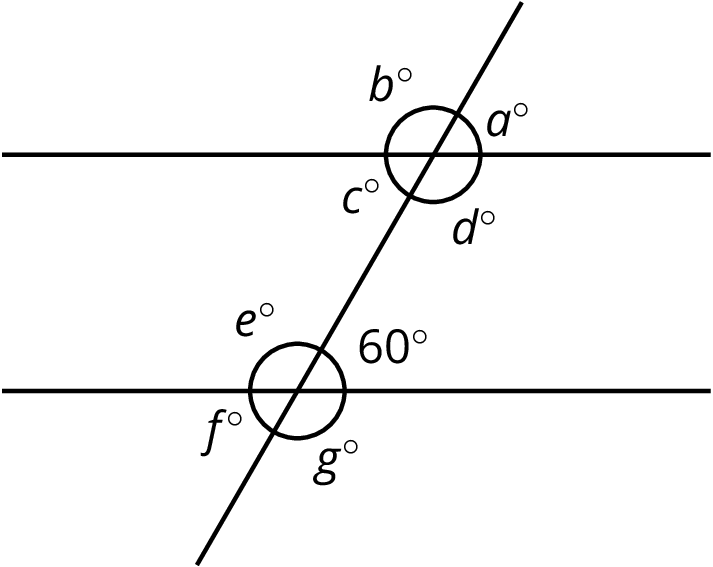
Select students to point out examples of alternate interior, vertical, and supplementary angles in the picture. They should also be able to articulate which angles are congruent to one another and give an example of a rigid transformation that explains why.
In particular, make sure students can articulate:
- \(c = 60\) because it is the measure of an angle forming an alternate interior angle with the given 60 degree angle.
- \(e = d = 120\) because they are also alternate interior angles, each supplementary to a 60 degree angle.
- The rest of the angle measures can be found using vertical or supplementary angles.
14.4: Cool-down - All The Rest (5 minutes)
Cool-Down
For access, consult one of our IM Certified Partners.
Student Lesson Summary
Student Facing
When two lines intersect, vertical angles are equal and adjacent angles are supplementary, that is, their measures sum to 180\(^\circ\). For example, in this figure angles 1 and 3 are equal, angles 2 and 4 are equal, angles 1 and 4 are supplementary, and angles 2 and 3 are supplementary.
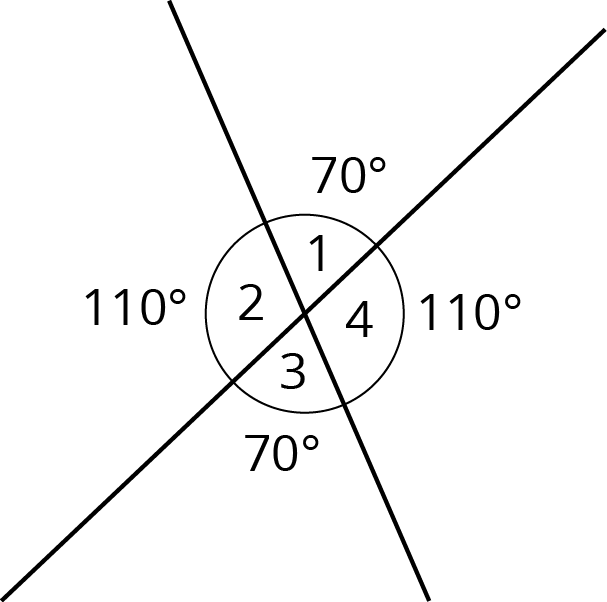
When two parallel lines are cut by another line, called a transversal, two pairs of alternate interior angles are created. (“Interior” means on the inside, or between, the two parallel lines.) For example, in this figure angles 3 and 5 are alternate interior angles and angles 4 and 6 are also alternate interior angles.
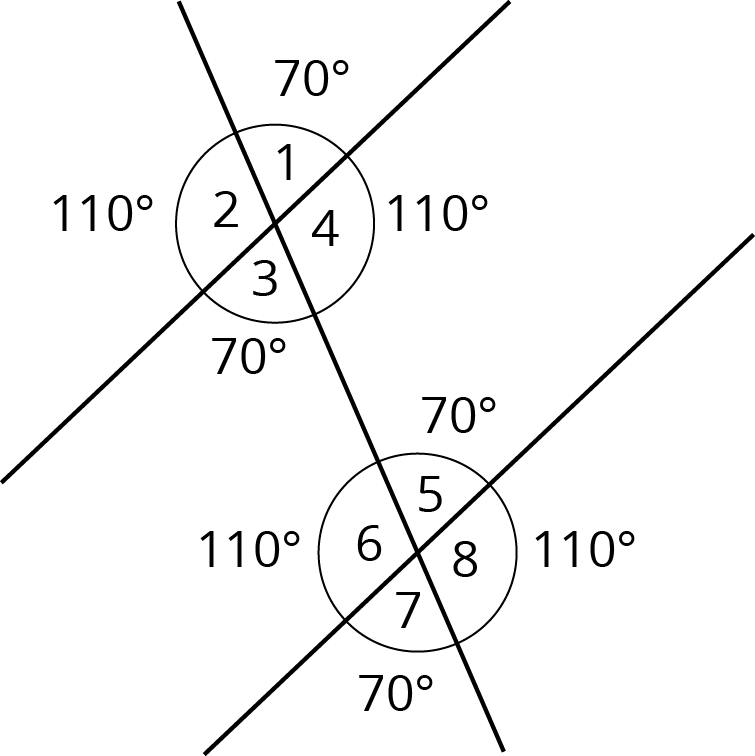
Alternate interior angles are equal because a \(180^\circ\) rotation around the midpoint of the segment that joins their vertices takes each angle to the other. Imagine a point \(M\) halfway between the two intersections—can you see how rotating \(180^\circ\) about \(M\) takes angle 3 to angle 5?
Using what we know about vertical angles, adjacent angles, and alternate interior angles, we can find the measures of any of the eight angles created by a transversal if we know just one of them. For example, starting with the fact that angle 1 is \(70^\circ\) we use vertical angles to see that angle 3 is \(70^\circ\), then we use alternate interior angles to see that angle 5 is \(70^\circ\), then we use the fact that angle 5 is supplementary to angle 8 to see that angle 8 is \(110^\circ\) since \(180 -70 = 110\). It turns out that there are only two different measures. In this example, angles 1, 3, 5, and 7 measure \(70^\circ\), and angles 2, 4, 6, and 8 measure \(110^\circ\).